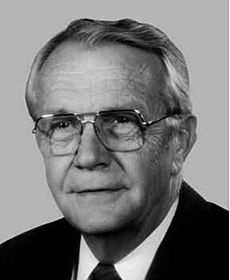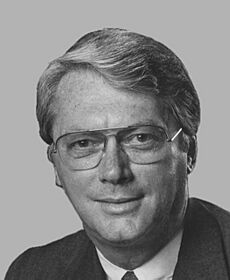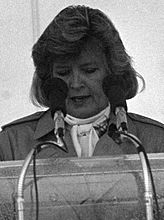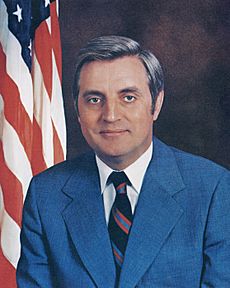Martha Layne Collins facts for kids
Quick facts for kids
Martha Layne Collins
|
|
|---|---|
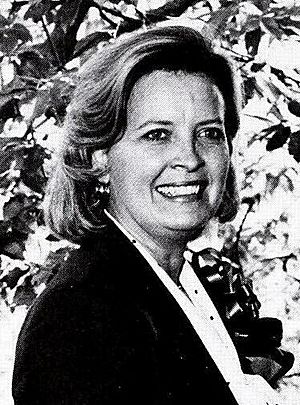
Collins in the early 1980s
|
|
| 56th Governor of Kentucky | |
| In office December 13, 1983 – December 8, 1987 |
|
| Lieutenant | Steve Beshear |
| Preceded by | John Y. Brown Jr. |
| Succeeded by | Wallace Wilkinson |
| 48th Lieutenant Governor of Kentucky | |
| In office December 11, 1979 – December 13, 1983 |
|
| Governor | John Y. Brown Jr. |
| Preceded by | Thelma Stovall |
| Succeeded by | Steve Beshear |
| Personal details | |
| Born |
Martha Layne Hall
December 7, 1936 Bagdad, Kentucky, U.S. |
| Died | November 1, 2025 (aged 88) Lexington, Kentucky, U.S. |
| Political party | Democratic |
| Spouse |
Bill Collins
(m. 1959) |
| Children | 2 |
| Education | Lindenwood University University of Kentucky (BS) |
Martha Layne Collins was an important American leader from Kentucky. She was the 56th governor of Kentucky from 1983 to 1987. She made history as the first woman to hold this high office in Kentucky. Before becoming governor, she served as the 48th lieutenant governor of Kentucky. Her election as governor made her a very influential woman in the Democratic Party across the country.
Collins focused on improving education and bringing new jobs to Kentucky. She worked hard to attract a large Toyota car manufacturing plant to the state. This plant created many jobs and helped Kentucky's economy grow. Martha Layne Collins passed away on November 1, 2025.
Martha Layne Collins: A Leader for Kentucky
Early Life and Education
Martha Layne Hall was born on December 7, 1936, in Bagdad, Kentucky. She was the only child of Everett and Mary Hall. When she was in sixth grade, her family moved to Shelbyville, Kentucky. Her parents were active in local politics. Martha Layne often helped them with campaigns. She would stuff envelopes and deliver flyers.
She attended Shelbyville High School. There, she was a good student and a cheerleader. She also won beauty pageants, including the Shelby County Tobacco Festival Queen in 1954. After high school, she went to Lindenwood College for a year. Then, she transferred to the University of Kentucky in Lexington, Kentucky. She was involved in many clubs and was a leader in her dormitory.
In 1957, she met Billy Louis Collins. They married shortly after she graduated in 1959 with a Bachelor of Science degree. While her husband studied dentistry, Martha taught at high schools in Louisville. The couple had two children, Steve and Marla. In 1966, they moved to Versailles, Kentucky. Martha taught at a junior high school there. They also became active in community groups and local politics.
Starting in Politics
By 1971, Martha Layne Collins was a well-known community leader. She was asked to help with Wendell Ford's campaign for governor. She was very good at organizing and helped Ford win. After his victory, she became a representative for Kentucky in the Democratic Party. She left her teaching job to work full-time in politics. She also worked on Walter Dee Huddleston's campaign for the United States Senate.
In 1975, Collins was elected Clerk of the Kentucky Court of Appeals. During her time, Kentucky's court system changed. The Court of Appeals became the Kentucky Supreme Court. Collins was the last person to be Clerk of the old court. She was also the first to be Clerk of the new Supreme Court. She helped people understand the court's new role. She created brochures and worked with schools to teach students about the changes.
Becoming Lieutenant Governor
In 1979, Martha Layne Collins ran for Lieutenant Governor of Kentucky. She won the election easily. As lieutenant governor, she often traveled across the state. She attended events when Governor John Y. Brown Jr. was unable to go. She visited all 120 counties in Kentucky during her term. Governor Brown was often out of state. This meant Collins served as acting governor for more than 500 days.
She also led the state Senate meetings. Lawmakers from both parties praised her fairness. She was good at following the rules of meetings. She even chaired the National Lieutenant Governors Association. She was the first woman to hold that position.
Kentucky's First Woman Governor
In 1983, Collins decided to run for governor. She won the Democratic nomination. In the main election, she ran against Republican Jim Bunning. Bunning was a famous baseball player. Collins won the election, becoming Kentucky's first and only woman governor.
After her election, there was some discussion about her husband's role. He was briefly named state treasurer for the Democratic Party. However, he resigned after media questions. Collins then focused on her new role as governor. She appointed many people who had helped her campaigns.
Improving Education for Students
When she became governor, Collins wanted to improve education. She asked for more money for schools. Her plan included mandatory kindergarten and special programs for younger students. She also wanted better training and testing for teachers. Some of her ideas were passed in 1984.
In 1985, Collins pushed for more education funding. She traveled across Kentucky to talk with citizens. She wanted to know what changes people wanted for schools. Her new plan included pay raises for teachers. It also aimed to reduce class sizes and provide aides for kindergarten teachers. The state legislature approved her plan. They raised a business tax to pay for it. A lawsuit filed under her leadership also led to the Kentucky Education Reform Act of 1990. This law greatly improved Kentucky's K-12 school system. It also created a state-funded preschool program.
A Chance for Vice President
As Kentucky's governor, Collins was the highest-ranking Democratic woman in the country. She was the only woman governor at the time. She appeared on TV shows and gave a response to President Ronald Reagan's weekly address. In 1984, she was chosen to lead the 1984 Democratic National Convention.
Walter Mondale, who was running for president, considered her as a possible running mate. He interviewed her for the role of Vice President of the United States. However, he eventually chose Congresswoman Geraldine Ferraro.
Bringing Toyota to Kentucky
One of Collins's biggest achievements was bringing Toyota to Kentucky. In 1985, she made several trips to Japan. She wanted to encourage Japanese companies to invest in Kentucky. Her efforts paid off when Toyota decided to build a large car manufacturing plant in Georgetown, Kentucky. This was an $800 million project.
The state offered Toyota incentives to come to Kentucky. These included money for land, employee training, and road improvements. The state legislature approved this plan. Some people worried about the cost. However, the Kentucky Supreme Court eventually ruled that the plan was legal. The Toyota plant created many jobs. It also encouraged other car companies to come to Kentucky. This led to record job growth and a lower unemployment rate during her time as governor.
Other Important Work as Governor
Collins also worked on other important issues. She helped pass a tougher law against impaired driving. She also chaired the Tennessee–Tombigbee Waterway Authority. This waterway opened to the public in 1985. She held leadership roles in several regional boards. These included the Southern Growth Policies Board and the Appalachian Regional Commission.
After Her Time as Governor
Kentucky governors could not serve consecutive terms at that time. So, Collins's term ended in December 1987. After leaving office, she taught at several universities. She was an "executive in residence" at the University of Louisville. She also taught classes on leadership at Harvard Institute of Politics.
From 1990 to 1996, Collins was the president of Saint Catharine College. This was a small Catholic college. She was the first president who was not a nun. College officials hoped she would raise the college's profile. After leaving Saint Catharine College, she directed an international business center at the University of Kentucky.
Later, she became an "executive scholar in residence" at Georgetown College. In 1999, she was named Honorary Consul General of Japan in Kentucky. This role involved promoting Japanese interests and culture in the state. She also chaired the Kentucky Task Force on the Economic Status of Women. In 2005, she became the chairwoman and CEO of the Kentucky World Trade Center. She also served on the boards of several companies.
Awards and Recognition
Martha Layne Collins received many awards for her leadership. In 1999, a group called Women Leading Kentucky created the Martha Layne Collins Leadership Award. She was the first person to receive this award. It recognizes women who inspire others through their lives and work.
In 2003, Kentucky's Bluegrass Parkway was renamed the Martha Layne Collins Bluegrass Parkway in her honor. That same year, she received the World Trade Day Book of Honor Award. In 2009, she was honored by the Japanese Ministry of Foreign Affairs. She received the Order of the Rising Sun, Gold and Silver Star. This award recognized her efforts to strengthen ties between Japan and the United States. Martha Layne Collins High School in Shelby County was named after her and opened in 2010.
See also
 In Spanish: Martha Layne Collins para niños
In Spanish: Martha Layne Collins para niños
- List of female governors in the United States
- List of female lieutenant governors in the United States
- Kentucky Colonel


